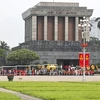 Both Vietnamese businesses and workers will feel the profound impact of the COVID-19 crisis. (Illustrative image. Source: VNA)
Both Vietnamese businesses and workers will feel the profound impact of the COVID-19 crisis. (Illustrative image. Source: VNA)
Hanoi (VNA) – The global health crisis caused by the COVID-19 pandemic has rapidly become a worldwide socio-economic crisis. In Vietnam, how will this crisis affect the economy and employment of workers in the future?
Dr. Chang-Hee Lee, Director of the International Labour Organisation in Vietnam (ILO), discussed challenges Vietnam might face during this crisis.
Question: A recent ILO quick report provides up-to-date forecasts about job loss and severe reduction in working hours worldwide. So what is the forecast for Vietnam?
Answer: It is too early to give any credible forecast for Vietnam, as we have no available data yet showing full impacts of COVID-19 on firms and jobs. We should wait until the release of the latest results of Labour Force Survey and Establishment Survey, which the General Statistical Office (GSO) is now working on with ILO support. There are some forecast based on surveys, such as Ministry of Planning and Investment’s estimate indicating 2 million jobs at risk, and VCCI survey telling that 50 percent of companies in Vietnam can survive maximum 6 months if the COVID-19 triggered economic crisis does not improve. But again we should wait until the results of GSO survey become available to get accurate picture of business performance and job loss.
However, one thing is clear. Most countries are facing a really difficult time as the world is experiencing an unprecedented severe crisis, the worst one since World War II. With various forms of lockdowns and social distancing, the global health crisis is quickly triggering a global economic and social crisis. According to the ILO’s latest estimates, full or partial lockdowns have affected almost 2.7 billion workers, representing 81 percent of the world’s workforce. The ILO Monitor released last week indicated that working hours will decline by 6.7 percent in the second quarter of 2020, which is equivalent to 195 million full-time workers.
Around 38 percent of the global workforce are employed in the sectors that are now facing a severe decline in output and a high risk of drastic and devastating increase in layoffs and reductions in wages and working hours. They include accommodation, food services, manufacturing, wholesale and retail trade, and real estate and business activities, transport, and entertainment.
In Vietnam, these sectors account for more than 22.1 million workers, or 40.8 percent of Vietnam’s employment. We are not saying that all of these workers would lose jobs – we are saying they are in high risk sectors which face enormous challenges for survival of enterprises and therefore for keeping their workforce.
And this has very important policy implications for policy-makers, businesses and workers in Vietnam. They are labour intensive sectors, employing usually low-skilled and low wage workers. And they are sectors where female workers tend to be predominant. It means that COVID-19 crisis hit harder vulnerable workers and female workers. The top four sectors at risk identified in the ILO note account for 44.1 percent of female workers in Vietnam, versus 30.4 percent of male workers. A special attention should be paid when the Government develops its support package in this regard. There is a grave concern that the unfolding crisis could further weaken their labour market situation.
Question: How about workers whose jobs are deprived of by the COVID-19 crisis? What should be done?
Answer: We do not know yet exact magnitude of employment crisis, as there is no latest labour force survey data available at this very moment. But signs are not good as I already quoted the Ministry of Planning and Investment forecast of more than 2 million workers at risk nationwide. It is certain that we now face a major employment crisis, which all – not only the government, but also enterprises, trade unions and workers – have to work together to minimise and mitigate.
Different enterprises are in different economic difficulties. There may be enterprises which cannot survive because of low productivity and low competitiveness, regardless of COVID-19 crisis. But there are also enterprises which are healthy and strong under normal circumstance, and which can survive long if they can be supported at the height of COVID-19 crisis, which blocks cash flaw, raw material and sudden fall of demands and order. It means the Government support should target those enterprises which have positive outlook as they are productive and innovative, but face temporary crisis. The Government should target those enterprises in its support packages.
And I would like to emphasize that the Government direct its support and subsidy package to enterprises which make best efforts to retain workers and to minimize layoff, by making adjustment to working hours, job sharing, on-the-job training, wage cuts which are consulted with trade unions and workers. It can encourage enterprises to make best efforts to retain workers or minimize layoff. Then, it can slowdown the process of layoff, minimizing societal shock it can trigger, while preserving workers’ productive capacity for quicker post-COVID 19 recovery.
In this sense, I believe that it is important for Vietnam General Confederation of Labour and Vietnam Chamber of Commerce and Industry to work together to jointly issue guidelines for employers and trade unions in managing employment crisis. ILO is ready to support such initiative.
Question: Vietnam depends largely on global trade. Does it mean Vietnam’s economy and labour market will be more severely impacted than many other countries?
Answer: Again, we do not have accurate and updated trade data for Vietnam. According to World Trade Organisation, the volume of global trade in 2020 is expected to fall between 13 percent and 32 percent. The first quarter trade data of Vietnam was not too bad, with 0.5 percent up in exports, 2 percent down in imports and 8.55 billion USD in foreign direct investment. But the full impacts of COVID-19 on trade and investment would be become clearer from the end of April. There are indications that it is going to be a lot worse in the second quarter, as for example, there is no new foreign tourists coming to Vietnam, while there is rapidly falling demands for Vietnamese goods in export markets, as most trade partner countries are under lockdown.
A problem is Vietnam heavily relies on global trade. So we can assume that the impacts of shrinking global trade would be felt much more strongly and deeply in Vietnam for both enterprises and workers.
It does not mean the country’s global integration strategy is wrong. On the contrary, it has proven to be a major driver of economic growth for Vietnam’s development success story. The Comprehensive and Progressive Agreement for Trans-Pacific Partnership (CPTPP) and EU-Vietnam free trade agreement will provide great opportunity, particularly, for faster post COVID recovery.
But in designing the post COVID-19 development strategies, the Government may have to think how to make global supply chains more resilient and also very importantly how to broaden domestic consumer markets, how to support domestic service industries, and how to upgrade the competitiveness of Vietnamese companies in more agile and resilient manner.
Question: Then how about the domestic service sector and domestic private enterprises, household businesses and farming, which may not be directly linked to the global supply chains?
Answer: They are not only extremely important during the height of COVID-19 economic crisis, when global demands for Vietnamese firms have fallen dramatically as the result of the disruptions in global supply chains, but also for longer term post-COVID-19 growth model.
Micro enterprises, family household business and rural farming were what supported Vietnam’s economy during the American war, together with the State sector. They can offer temporary shelters to workers who may lose their jobs and return to their home town or rural villages. They have been the traditional source of societal resilience, and they will unfortunately play the traditional vital roles again at the height of the COVID-19 crisis.
A problem is that the magnitude and speed of the COVID-19 employment crisis may be far greater than household businesses and rural farming families can absorb. There should be a targeted Government support to them in various forms of subsidy so that people can endure the hardest moments of the crisis until the situation begins to return to normal gradually. In this sense, tough version of ‘social distancing’ may have to be gradually eased so that economic activities of micro enterprises and household businesses can provide their vital source of people’s life, resilience and peace. Of course, it should be ‘safe and healthy business’ with proper guidelines on social distancing in place throughout business activities. I think Vietnam Cooperative Alliance and Vietnam Small and Medium-sized Enterprises Association has important roles to play through its network of cooperatives in urban and rural areas.
In the longer term, it is strategically important to formalize informal businesses, to expand domestic consumption base, and to support domestic service industry. The country of almost 100 million population should develop substantial domestic markets led by domestic firms – this is one of most effective strategy to make Vietnam’s economy resilient against external shocks. Formalization also comes with various social protection measures, which will make Vietnamese society more resilient against similar global health crisis in the future.
- Thank you so much!

























